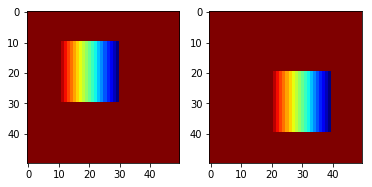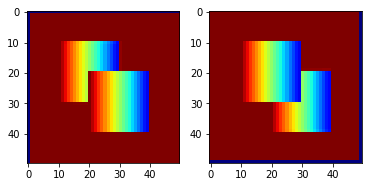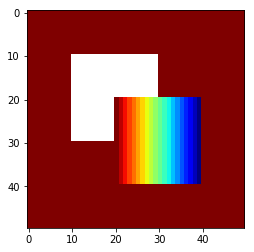Direct Warp module
This module has been created in the context of my PhD thesis.
Robust Learning of a depth map for obstacle avoidance with a monocular stabilized flying camera
See dedicated page here
this is a custom C++/Cuda implementation of Direct Warp module, a simple graphic pipeline for direct image warping, designed so that occluded area are invalid. Be careful, this operation is not spatially differentiable !
This tutorial was used as a basis for implementation
- Build and Install C++ and CUDA extensions by executing
python setup.py install, - Test three modules by executing
python test_projection.py,python test_warping.pyandpython test_occlusion_map.py
Requirements
This module is expected to compile on Pytorch >= 1.11.0 (tested on 1.12.1, CUDA 11.6), Python > 3.5
Usage direct projection
from pytorch_direct_warp.direct_proj import direct_projection
Every image to warp is considered as a "square" cloud, so each point will have a 3D position and a size.
input (B x C x N), pos and size (B x N x 4), frame matrix (B x 3 x 3) -> output (B x C x H x W), warped depth (B x H x W)
Its rendering is based on a simple loop which will colorize the area [(x-s/2)z, (x+s/2)/z] x [(y-s/2)/z, (y+s/2)/z] provided it has not already been colorized with a closer square (lower z). x,y,z,s are the 4 parametersof the point cloud pos_size.
Note that for a simple warp, size s is equal to depth z, because it is the exact size so that the camera field of view is completely filled. Alos, Number of points N is simply unravelled depth dimensions H * W
if input is not provided, only warped depth is outputted.
As there is not interpolation, outputs are not spacially differentiable, but the module keeps a lookup table so that pixel value (depth and input) differentiation is back propagated
Usage direct warping
from pytorch_direct_warp.direct_warp import DirectWarper
Thanks to this wrapper, direct depth and img warping is simplified. You need to provide a BxHxW depth tensor and an optional BxCxHxW image tensor, as long as a Bx3x4transformation matrix, and Bx3x3 intrinsics and its inverse.
Occlusion map generator
Occlusion map for a depth and a pose can be obtained by warping depth and warping it back. Missing points in the resulting output have been detected as occluded or out of bound, and it is reasonable to dismiss them from any photometric loss since these points don't occur in the next frame.
This operation does not need any differentiation, it is designed to be used with an inverse warping operation, e.g. here
Inverse warp vs Direct Warp examples
This section discusses the fundamental differences between direct and inverse warping for a set of points with depth and pose.
Throughout the whole experiment, we consider two 50x50 Images I1 I2 and a depth Map D corresponding to I1. If specified otherwise, the pose between the two frames is P = T[-1,-1,0], R identity, which means the camera went up and left with no rotation.
Using frame matrix and depth, we can get a point cloud corresponding to 2D coordinates in I1 and with the pose, in I2 . In the end, the needed coordinates can be summed with this (u,v) chart T of I1 pixels in I2. you then get for [i,j] in [0,50]x[0,50]
Î1[i,j] = I2[T[i][j]]
By using these coordinates, inverse warp will try to reconstruct I1 with pixels from I2, while direct warp will try to reconstruct I2 with pixels from I1.
As you can see, while the inverse warp shows duplication artefacts, the direct Warp shows Nan values where no colorization was done. The main interest of this direct warp here is to warp and warp back the depth in its original coordinate system. That way, you can see that occluded values are now considered NaNs.
A more in depth study of this occlusion module is avalaible at this address : https://github.com/ClementPinard/thesis-notebooks



